The Best Water Plants: Aquatic Plants for Ponds (Indoors and Outdoors)
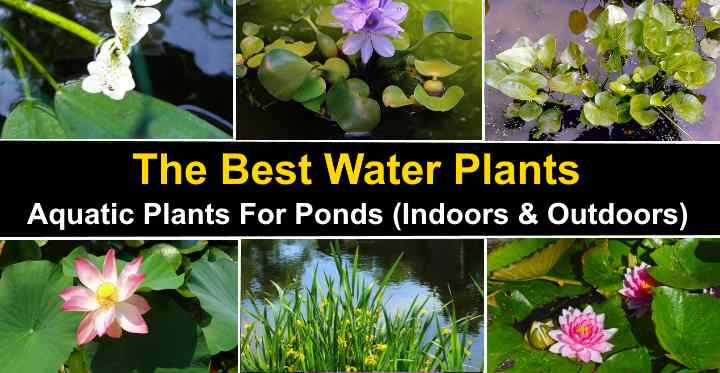
Water plants are excellent for adding attractive natural features to ponds in your backyard, indoor ponds, or aquariums. Aquatic plants, also referred to as hydrophytes, are the types of plants that grow only in water, not on land. In ponds or fish tanks, water plants provide oxygen, shaded areas, and prevent algae from thriving.
Some aquatic plants emerge above the water surface, whereas other water plants have leaves that float on the water surface.
There are also submerged water plants that grow completely under water, and free floating pond plants where the roots are not attached to the bottom soil.
Plants that naturally grow partially submerged in water, such as umbrella palm, cattail and horsetail, are called semi aquatic plants.
Examples of water plants include: Water purslane, waterweed plants, African water fern plant, and Anubias. Some of the best floating water plants on ponds are duckweed and the mosaic flower.
Some of the best aquatic flowers are water lilies, lotus, water hawthorn plants, and mosaic flower. Water iris is a marginal aquatic flowering plant with showy blue or yellow flowers.
In this article, you’ll learn about the best water plants to grow in indoor or outdoor ponds in your backyard or at home. If you want to decorate a pond with flowers, provide fish with a natural environment, or grow an indoor pond, you’ll find suitable water aquatic flowers.
What Are Water Plants?
Water plants are plants that live in aquatic environments, either fully submerged or partially submerged in water. Plants that survive in water are classified depending on how and where they grow in aquatic conditions. The four types of water plants are emergent plants, submerged plants, free-floating plants, and floating-leaved plants.
The Four Types Of Water Plants
Here are the four types of water plants:
- Emergent water plants. Also called marginal plants, these water plants have roots in the sediment of shallow water, usually close to the pond’s edge. The plant’s foliage mainly grows above the water level.
- Submerged aquatic plants. These types of water plants are also called oxygenating pond plants. The stems and leaves of these freshwater and saltwater aquatic plants grow entirely underwater.
- Free-floating pond plants. Some flowering aquatic plants float freely in the water. Their roots don’t grow in sediment or soil, and they absorb minerals from pond or lake water.
- Floating-leaved water plants. The most beautiful and striking water plants are deep-water plants. These plants, such as water lilies and lotus, are rooted at the bottom of the pond. The long stems reach the pond’s surface where their leaves and flower appear to float.
Growing Indoor Water Plants
Water plants are ideal for growing in indoor water gardens or as aquarium plants. Many types of plants that grow in water are suitable for floating on indoor ponds, water terrariums, or fish tanks. The only difference between indoor aquatic plants and outdoor ones is the amount of sunlight they need.
When choosing water plants to grow indoors, make sure they grow well in the shade. Aquarium plants usually grow under artificial light, but the tanks are typically covered. Growing underwater, plants for fish tanks need to survive the shady conditions. However, water plants for full sun grow well in water terrariums on sunny windowsills.
Another way to grow aquatic plants in water indoors is in a jarrarium. A jarrarium is a self-sustaining water ecosystem. The large glass jar or tank contains indoor aquatic plants that grow submerged in water. Think of a jarrarium as a jar filled with water and plants that doesn’t have any fish.
When talking about plants that grow in water, it’s important to distinguish between aquatic plants and houseplants. Indoor plants usually grow in potting soil in containers. But many can also grow in water for a few weeks or even months. There is also a plant-growing system called hydroponics—where indoor plants grow without soil.
However, this article deals specifically with water plants—those that only grow in aquatic environments.
Water Plants That Grow in Ponds Indoors (With Picture and Name)
Let’s look in more detail at water plants you can grow indoors in small ponds, tanks, aquariums, or jarrariums. Of course, all the plants listed below grow outdoors in ponds and wetlands in their native habitats.
African Water Fern Plant (Bolbitis heudelotii)
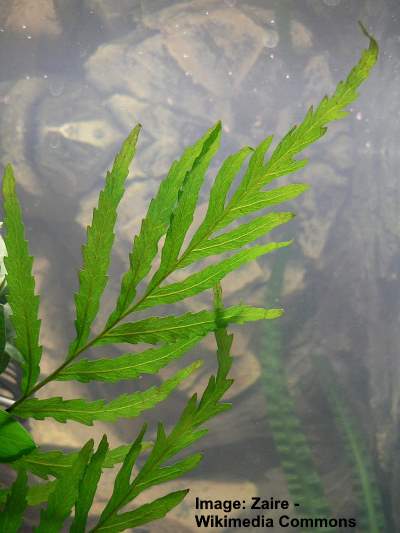
The African water fern is a plant that grows underwater and it prefers shady location
The African water fern is a submerged water plant. This aquatic plant is a popular choice for oxygenating water. Also called Bolbitis water fern, this perennial aquatic plant has dark green pinnate leaves that can grow to between 6” to 15” (15 – 40 cm) long. This shade-loving leafy plant is ideal for aquariums and jarrarium.
African water fern plants thrive better in freshwater aquariums than indoor pools. Oxygen supplementation helps boost growth, and their underwater roots will cling to submerged pieces of wood.
Anubias – Flowering Water Plant
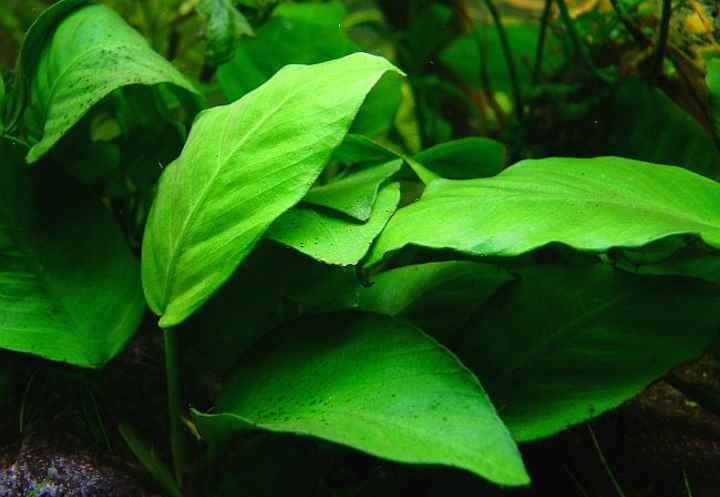
Anubias barteri ‘nana’ is a popular slow growing water plant that is easy to propagate and care for
Anubias are trendy indoor aquatic plants with lush green foliage. These freshwater plants thrive underwater or partially submerged. Anubias aquatic plants have broad, green leaves and are popular for decorating the bottom of aquariums. Under ideal conditions anubias produces white flowers.
Anubias plants grow well in low to moderate light. The slow-growing water plant is also useful for decorating jarrariums. However, you may need to supplement the water with nutrients for these plants to grow in water indoors.
Duckweed Floating Indoor Pond Plant (Lemnaceae)
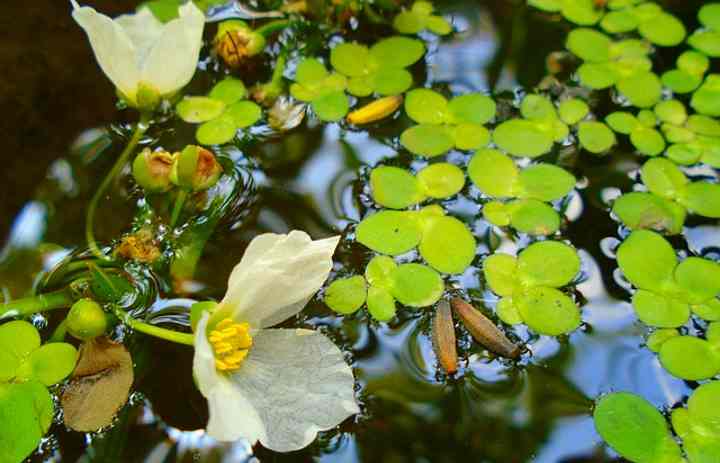
Duckweed is a floating flowering water plant with small leaves
Duckweed is an excellent oxygenating water plant for indoor aquatic environments. Also called water lentils, duckweed is one of the smallest flowering water plants that floats on water. Depending on the duckweed species, the floating leaves can measure between 0.5 mm to 6 mm.
Duckweed is a popular aquarium plant and pond plant to provide fish shelter. Growing these indoor water plants will help keep tanks free from algae. This water plant can be invasive in wetlands, and it will thrive just as well in full sun or low light.
Eelgrass (Vallisneria) – Freshwater Aquatic Plant
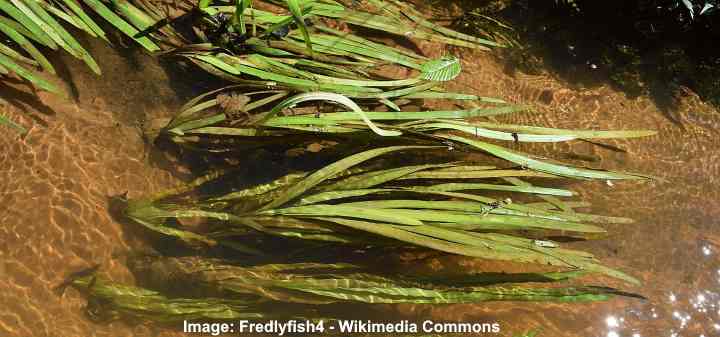
Vallisneria is a freshwater aquatic plant that grows well under bright to moderate light
Eelgrass is a lush water plant that is excellent for purifying water. Also called the tape plant due to its long green ribbon-like leaves, these submerged plants have long thin blades measuring between 6” and 23” (15 – 60 cm) long. Eelgrass produces dainty white flowers on the end of long stems that float on the water’s surface.
The water plants are ideal for large indoor aquariums to provide a natural green backdrop and a place for large and small fish to hide.
Amazon Sword Plant for Indoor Ponds (Echinodorus)
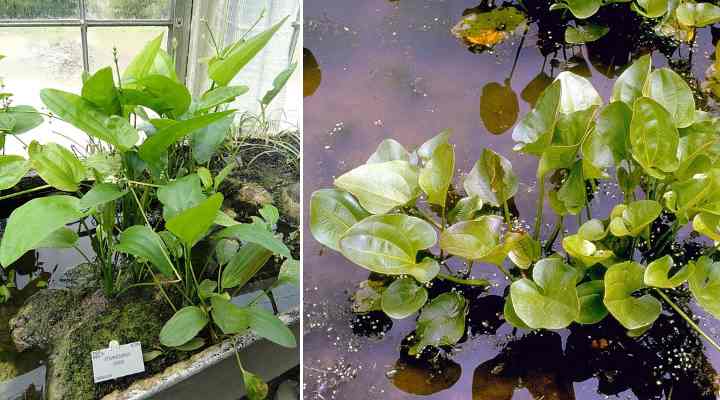
Echinodorus water plants include various species. In the picture: E. uruguayensis (left) and E. cordifolius (right)
Amazon sword aquatic plants are beautiful leafy water plants for oxygenating indoor ponds and fish tanks. These aquatic plants have broad, bright green, lanceolate leaves. They grow rooted at the bottom of ponds and aquariums. The perennial pond plants help improve water quality by removing toxic chemicals and algae.
These aquatic plants prefer good amount of light and can also grow submersed in water in fish tanks or indoor ponds. The lime-green leaves grow to between 8” and 20” (20 – 50 cm) tall.
Water Plants That Grow in Ponds Outdoors (With Picture and Name)
Here are the best water plants to grow in ponds outdoors:
Water Hyacinth (Eichhornia crassipes)
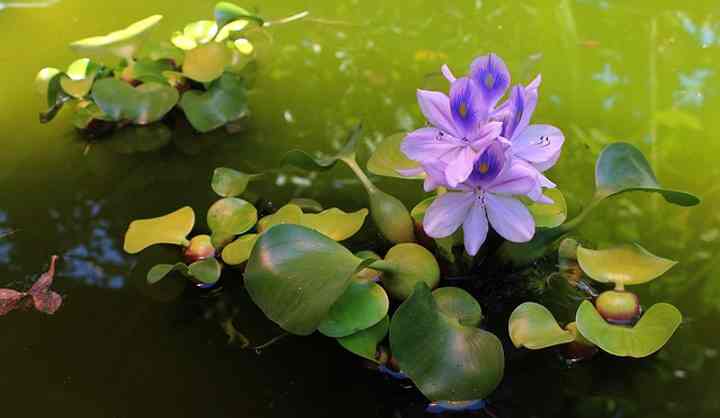
The purple flowers of water hyacinth will add decorative touch to any pond
Water hyacinths are beautiful free-floating perennial flowering water plants. These floating plants are fast-growing with broad green leaves. The stems and flowers emerge from a bulb that floats and can grow up to 3 ft. (1 m) above the water’s surface. Growing outdoor in ponds and lakes, water hyacinths need plenty of sunlight and a minimum temperature of 54°F (12°C).
If you decide to grow water hyacinths in your backyard pond, be aware that they can become invasive. You can also grow the spectacular flowering water plants in an indoor pond.
Water Lilies (Nymphaeaceae)
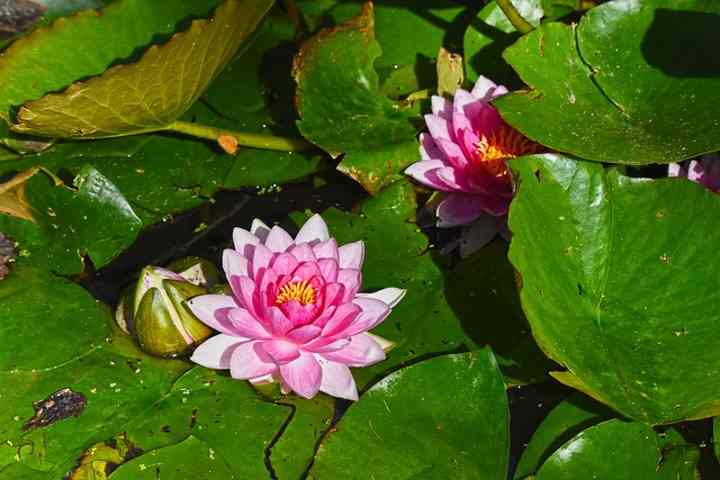
Water lilies are ornamental plants with beautiful floating flowers in various colors
Water lilies produce the most stunning water flowers that float on the surface of ponds. Species of water lilies are a type of deep-water plant with long stems that reach from the bottom of ponds to the water’s surface. Water lily leaves seem to float on the surface, creating a lily pad.
Unlike lotus aquatic flowers, water lily flowers float on the water’s surface.
The most beautiful feature of these flowering pond plants is their flowers. Large, showy, star-shaped flowers can be orange, white, pink, purple, or yellow. Some of the most spectacular water lily flowers are multicolored and up to 6” (15 cm) across.
Lotus (Nelumbo nucifera) Flowers for Outdoor Ponds

The stunning flowers of lotus can be pink or white and grace any pond
Lotus is one of the most exotic flowering pond plants. These water plants are rooted in the soil at the bottom of ponds with long submerged stems that grow leaves and flowers above the water surface. This type of plant has huge leaves that can grow up to 31” (78 cm) in diameter. Its whitish-pink flowers bloom at the end of long stalks.
Unlike water lilies, lotus flowers appear above the pond’s surface.
Growing lotus water plants in ponds is useful for purifying water. They are one of the best freshwater aquatic plants that remove harmful toxins and heavy metals. Grow in full sunlight. You can also enjoy these exotic plants indoors in an indoor garden pond but make sure it has plenty of light. Ensure that the water level is at least 2” (5 cm) above the soil level.
Water Iris (Iris pseudacorus) — Flowering Pond Plants

Water iris is a flowering perennial plant that grows in temperate regions as an ornamental plant
One of the most beautiful flowering emergent water plants is the water iris. Beautifying the edges of backyard ponds, lakes, and rivers, the plant’s showy yellow flowers grow on the end of long stalks with sword-shaped leaves. These marginal plants grow partially submerged in water.
Grow water Iris in full sun or part shade. These low-maintenance water plant is suitable for a bog garden as it grows in damp, soggy soil that other plants find challenging.
Water Poppy (Hydrocleys nymphoides)
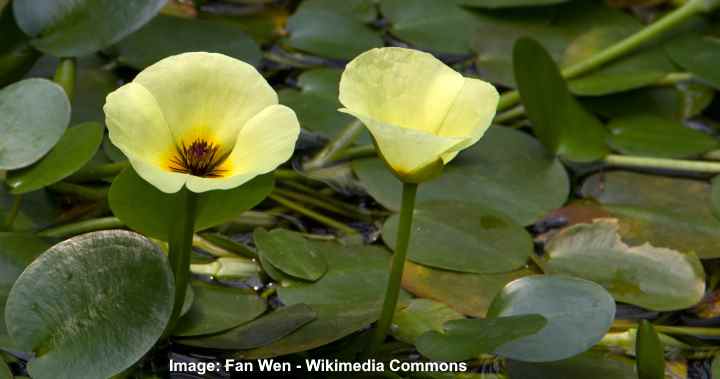
Water poppy is commonly grown in ponds as a decorative aquatic plant
Water poppies are an excellent plant for fish ponds to add color, filter water, and provide oxygen. The small green oval leaves of these free-floating aquatic plants complement its dainty yellow-cream colored flowers. You can also grow the plants fully submerged in water. Their leaves and flowers eventually grow on the surface of your pond.
Water poppies thrive in full sun. Ideally, the water plants should grow about 6″ (15 cm) below the pond’s surface. The floating leaves provide shade for koi or other outdoor pond fish.
Fanwort (Cabomba caroliniana)
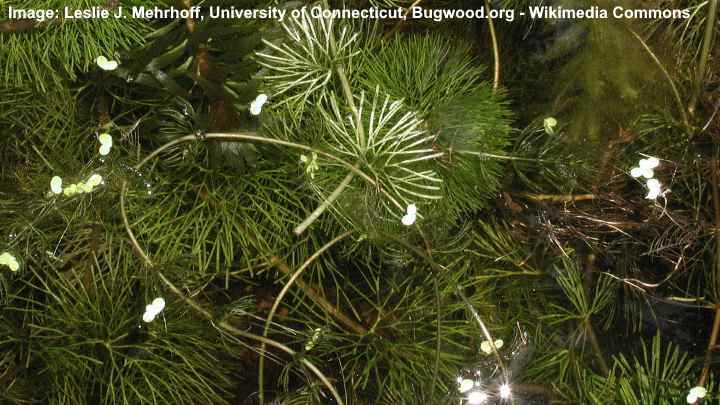
Fanwort is an aquatic perennial plant with small white flowers
Fanwort is a perennial aquatic freshwater rooted plant with submerged or floating leaves and white flowers. Plant fanwort in backyard fish ponds to oxygenate the water and provide fish with shade. When grown in water, fanwort has a bushy, spiky appearance, and the small flowers extend above the water’s surface on stems.
American Waterweed (Elodea canadensis)
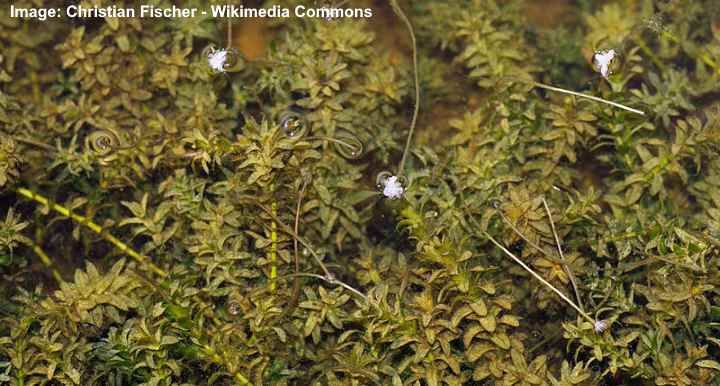
American waterweed is a flowering water plant with small white flowers. It grows fast in moderate to bright light.
American waterweed is a popular pond plant and aquarium plant. You can identify this plant by its long stems and small leaves growing underwater. This green water plant is ideal for boosting water oxygen levels and providing fish with hiding places. Its bright green foliage proliferates, with propagation taking place when leaves break off and root in another part of the pond.
Water Purslane (Lythrum portula)
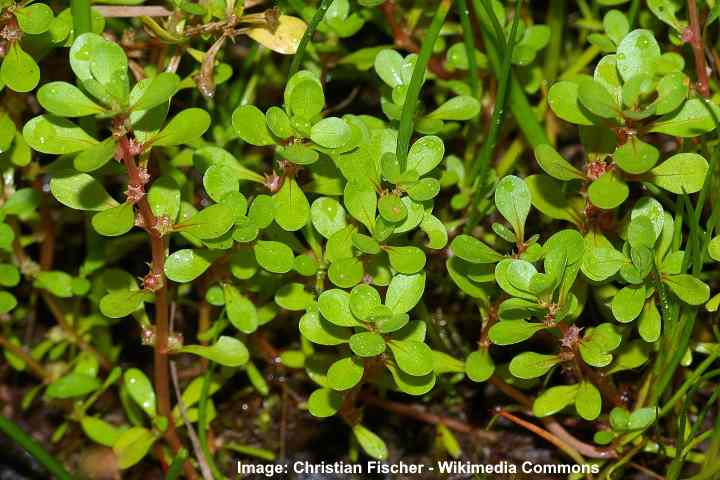
Water purslane has small slightly fleshy leaves and grows well in moist environments
Grow water purslane in backyard ponds as an excellent water oxygenator. The fast-growing plant grows as a perennial or annual depending on the climate and thrives in partial shade or full sun. Small spatula-shaped leaves create a mat of foliage over the water’s surface.
Water purslane grows well in marshy areas as a marginal water plant, floating on the water, or submerged underwater.
Rough Horsetail (Equisetum Hyemale)

The long stems of rough horsetail can spread quickly when grown in full to partial sun
Rough horsetail is an excellent emergent water plant to grow at the edges of ponds. The water plant has an aggressive growing nature and will need regular pruning. The long thin rush-like stems add a stunning vertical height of around 3 ft. (0.9 m) to your ponds.
To control growth, grow in containers before submerging the roots in your pond’s soil.
Umbrella Palm (Cyperus alternifolius)
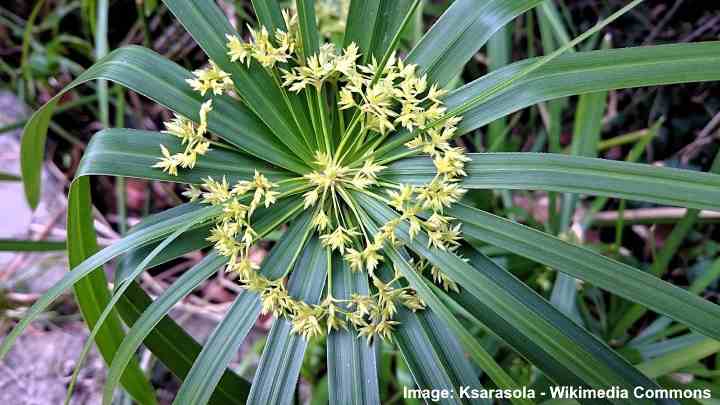
The umbrella palm, also called umbrella papyrus, is a water plant that can add vertical decorative touch to your pond
The umbrella palm is an impressive pond plant with long stems and a palm-like crown. Grow this emergent aquatic plant to add an exotic look to your backyard aquascape. Because it grows up to 6 ft. (2 m), umbrella palms also add visual height to your ponds. To grow umbrella palms in ponds, plant in containers to control its fast growth.
Mosaic Flower (Ludwigia Sedoides)
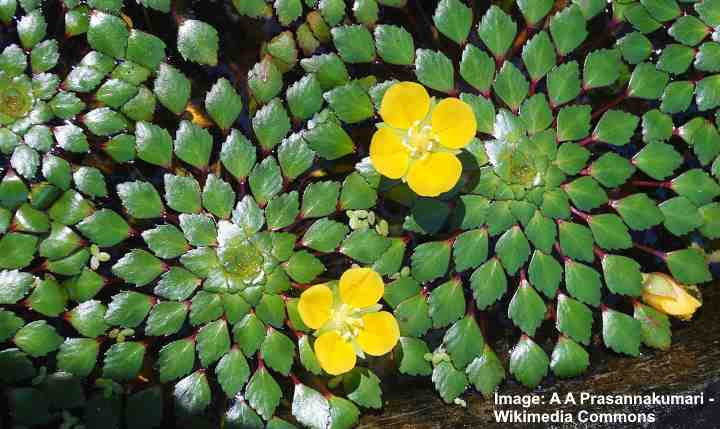
The mosaic flower is a floating pond plant that blooms from June to August
The mosaic flower is one of the most stunning floating aquatic pond plants. Its diamond-shaped reddish-green leaves form an ornate shape on the water’s surface. When growing in full sun, this perennial water plant produces beautiful yellow flowers in the summer. Grow the floating leaf-plant in fish ponds for shade and protection.
Cattail (Typha)
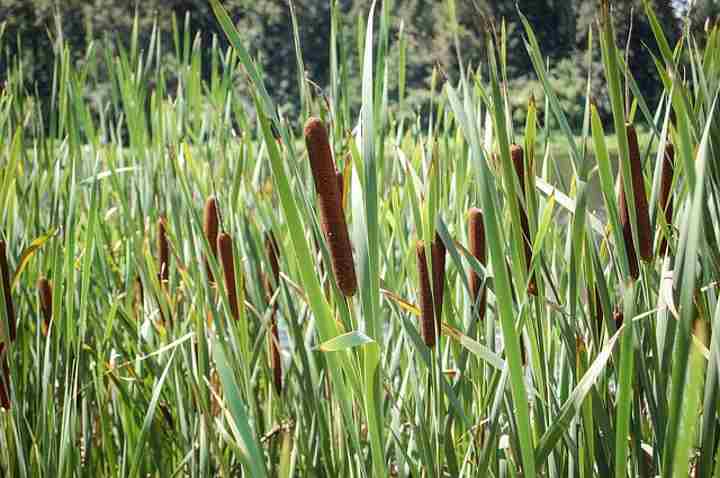
Cattail water plants include about 30 species that grow in wetland environments
Cattail is another excellent marginal water plant to add visual height to your backyard pond. Other common names for this popular emergent plant is bulrush, reedmace, and reed. These aquatic or semi-aquatic perennials thrive at the edges of lakes and ponds.
Depending on the species, the long thin reeds can grow to between 2 and 6 ft. (0.6 – 2 m) tall. An identifying feature of cattail is the large, sausage-like growth on the ends of the reeds.
Water Hawthorn (Aponogeton distachyos)
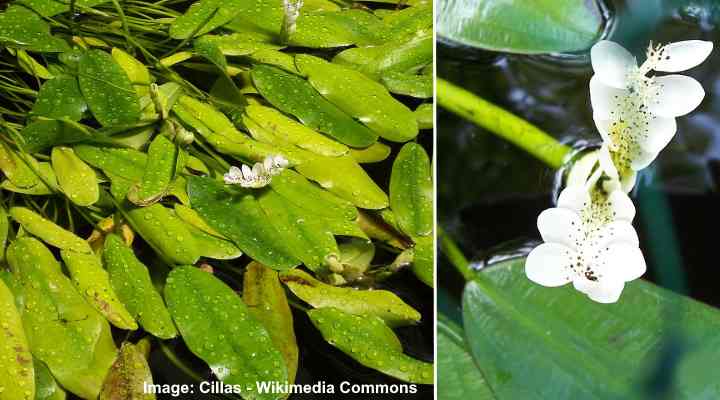
Water hawthorn is an aquatic flowering plant with scented white flowers
Water hawthorn is a stunning aquatic flowering plant. Its large lanceolate leaves float on the pond’s surface, creating a blanket of lush foliage. Dainty flowers emerge at the end of erect stems. The growth habit of water hawthorn plants is similar to water lilies. These are best-suited to shallow ponds of up to 3 ft. (1 m) deep.
The beautiful white flowers emit a sweet scent when grown in full sun.
Flowering Water Plants – Beautiful Aquatic Flowers
Growing flowering aquatic plants in a garden pond provides beautiful aromas and colors. Some of the best water plants that flower have huge, showy blooms. When these pond plants thrive and reproduce, they can cover a wide area of a pond.
Here is a list of the top aquatic flowering plants:
- Water iris. These are emergent aquatic flowering plants and their flowers are generally bright, sunny yellow in color.
- Lotus plants. These flowering water plants have exotic flowers can float on ponds or grow tall on long stems. Some of the most stunning lotus water flowers can be up to 8” (20 cm) in diameter.
- Water lily plants. There are 60 species of water lilies, and they have some of the showiest aquatic flowers of all the water plants. Their flowers are generally star-shaped and heavily scented. Pink, yellow, purple, white, orange, and red flowers contrast with the large floating leaves.
- Water hawthorn plants. These flowering water plants grow long erect blossoming stems that extend beyond the pond’s surface. The small white flowers give off a delightful aroma similar to hawthorn.
- Mosaic flower. Stunning floating aquatic pond plants.
- Flowering water poppies
Related articles:
- Plants that Grow in Water: Herbs, Indoor Plants and more Plants
- The 14 Most Beautiful Aquatic Flowers to Grow in Water
